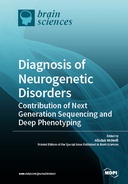Explore

Diagnosis of Neurogenetic Disorders: Contribution of Next Generation Sequencing and Deep Phenotyping
Alisdair McNeill
2019
0 Ungluers have
Faved this Work
Login to Fave
The contribution of genomic variants to the aetiopathogenesis of both paediatric and adult neurological disease is being increasingly recognized. The use of next-generation sequencing has led to the discovery of novel neurodevelopmental disorders, as exemplified by the deciphering developmental disorders (DDD) study, and provided insight into the aetiopathogenesis of common adult neurological diseases. Despite these advances, many challenges remain. Correctly classifying the pathogenicity of genomic variants from amongst the large number of variants identified by next-generation sequencing is recognized as perhaps the major challenge facing the field. Deep phenotyping (e.g., imaging, movement analysis) techniques can aid variant interpretation by correctly classifying individuals as affected or unaffected for segregation studies. The lack of information on the clinical phenotype of novel genetic subtypes of neurological disease creates limitations for genetic counselling. Both deep phenotyping and qualitative studies can capture the clinical and patient’s perspective on a disease and provide valuable information. This Special Issue aims to highlight how next-generation sequencing techniques have revolutionised our understanding of the aetiology of brain disease and describe the contribution of deep phenotyping studies to a variant interpretation and understanding of natural history.
This book is included in DOAB.
Why read this book? Have your say.
You must be logged in to comment.
Rights Information
Are you the author or publisher of this work? If so, you can claim it as yours by registering as an Unglue.it rights holder.Downloads
This work has been downloaded 185 times via unglue.it ebook links.
- 163 - pdf (CC BY-NC-ND) at Unglue.it.
Keywords
- Alzheimer’s disease (AD)
- amyotrophic lateral sclerosis (ALS)
- ataxia
- cerebellar hypoplasia
- deep learning
- Dementia
- Diagnosis
- disease phenotyping
- Gaucher disease
- genetic biomarker
- glucocerebrosidase
- inborn error of metabolism
- Machine learning
- metal storage disorders
- movement science
- n/a
- neurodegenerative disease
- next generation sequencing (NGS)
- p.(Arg2His)
- p.(Arg2His), R2H
- Parkinsonism
- parkinson’s disease
- Parkinson’s disease (PD)
- polymicrogyria
- R2H
- risk prediction
- TUBA1A
- tubulin
- tubulinopathy
Links
DOI: 10.3390/books978-3-03921-611-6Editions


